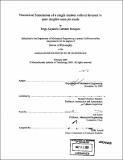Numerical simulation of a single emitter colloid thruster in pure droplet cone-jet mode
Author(s)
Carretero Benignos, Jorge Alejandro, 1972-
DownloadFull printable version (9.280Mb)
Other Contributors
Massachusetts Institute of Technology. Dept. of Mechanical Engineering.
Advisor
Manuel Martínez-Sánchez.
Terms of use
Metadata
Show full item recordAbstract
New Scientific missions call for emerging propulsion technologies capable of fine tuning a satellite's relative position and cancelling small disturbances. One candidate technology that holds promise for these type of missions are colloidal thrusters. These thrusters are electrostatic accelerators which do not rely on gas ionization (plasma), are intrinsically small, and operate at low power levels, while having small plume divergence angles to avoid spacecraft (S/C) contamination problems. Colloid thrusters deliver low thrust (0.1 [mu]N/emitter) which can be multiplied many times over by integrating them in microfabricated arrays. An important advantage is that with proper choice of propellant and operating regime their specific impulse can be tailored from 500-7000 seconds making them viable candidates for a multitude of mission profiles. In the past many research groups have worked on developing colloid thrusters; however, their basic physics are still not completely understood. For this reason, we have undertaken the development of a numerical simulation of a colloid thruster to complement experimental and analytical research in the area. The goal of this project has been to create a flexible numerical tool to compute single-emitter current, droplet size, velocity, electric field strengths for a given geometry, fluid, flow rate, and voltage. We have approached this issue from the numerical perspective by developing a simulation of a colloid thruster operating in the single cone-jet pure droplet mode. Our numerical simulation models the cone-jet transition region of the colloid jet; starting from the needle up to the extractor grid, thus reproducing a typical electrospray experimental configuration. (cont.) The liquid is modelled as an incompressible viscous fluid with constant conductivity. Surface charge relaxation effects are included, and the potential and electric fields are solved for. The equations have been simplified by employing a slenderness approximation except for the free surface boundary conditions where the terms have been kept exact, in order to reproduce the Taylor cone shape correctly. Simulation results are shown to compare well to experimental data for a variety of liquids, and flow rates. In more detail, this thesis presents (a) results for a broader parametric range than previously published materials; (b) careful comparison to available experimental data and scalings proposed by several authors; (c) validation of several simple sub-models for the cone and jet sections; (d) analysis of length scales in the cone-jet transition region; (e) clarification of the role of relative permittivity for the range 7-110; (f) discussion of electrode geometry and counter-electrode effects; (g) preliminary results for the onset of ion evaporation.
Description
Thesis (Ph. D.)--Massachusetts Institute of Technology, Dept. of Mechanical Engineering, 2005. Includes bibliographical references (leaves 112-117).
Date issued
2005Department
Massachusetts Institute of Technology. Department of Mechanical EngineeringPublisher
Massachusetts Institute of Technology
Keywords
Mechanical Engineering.